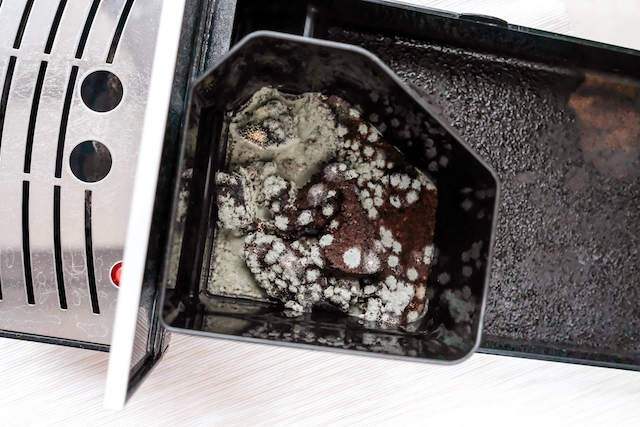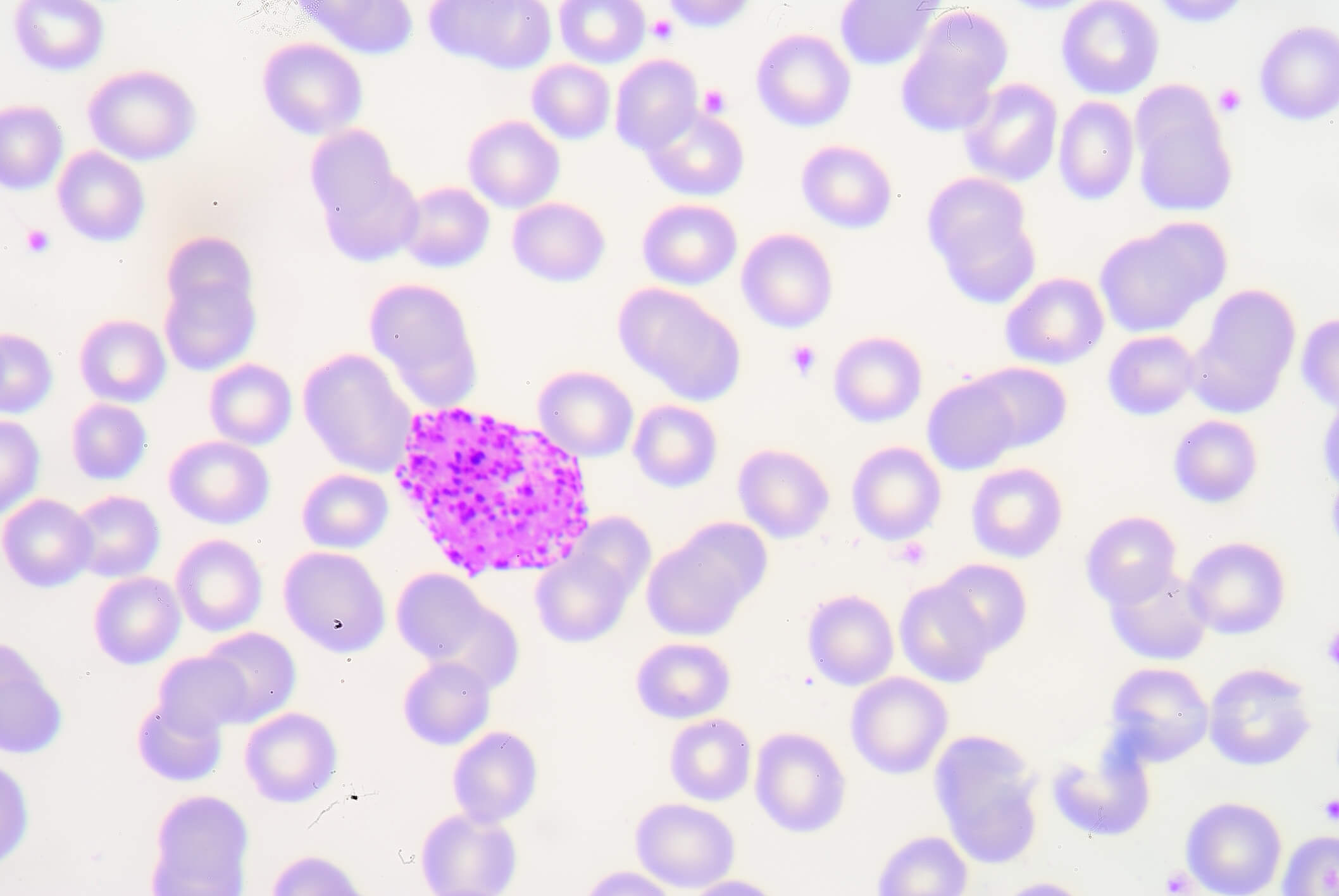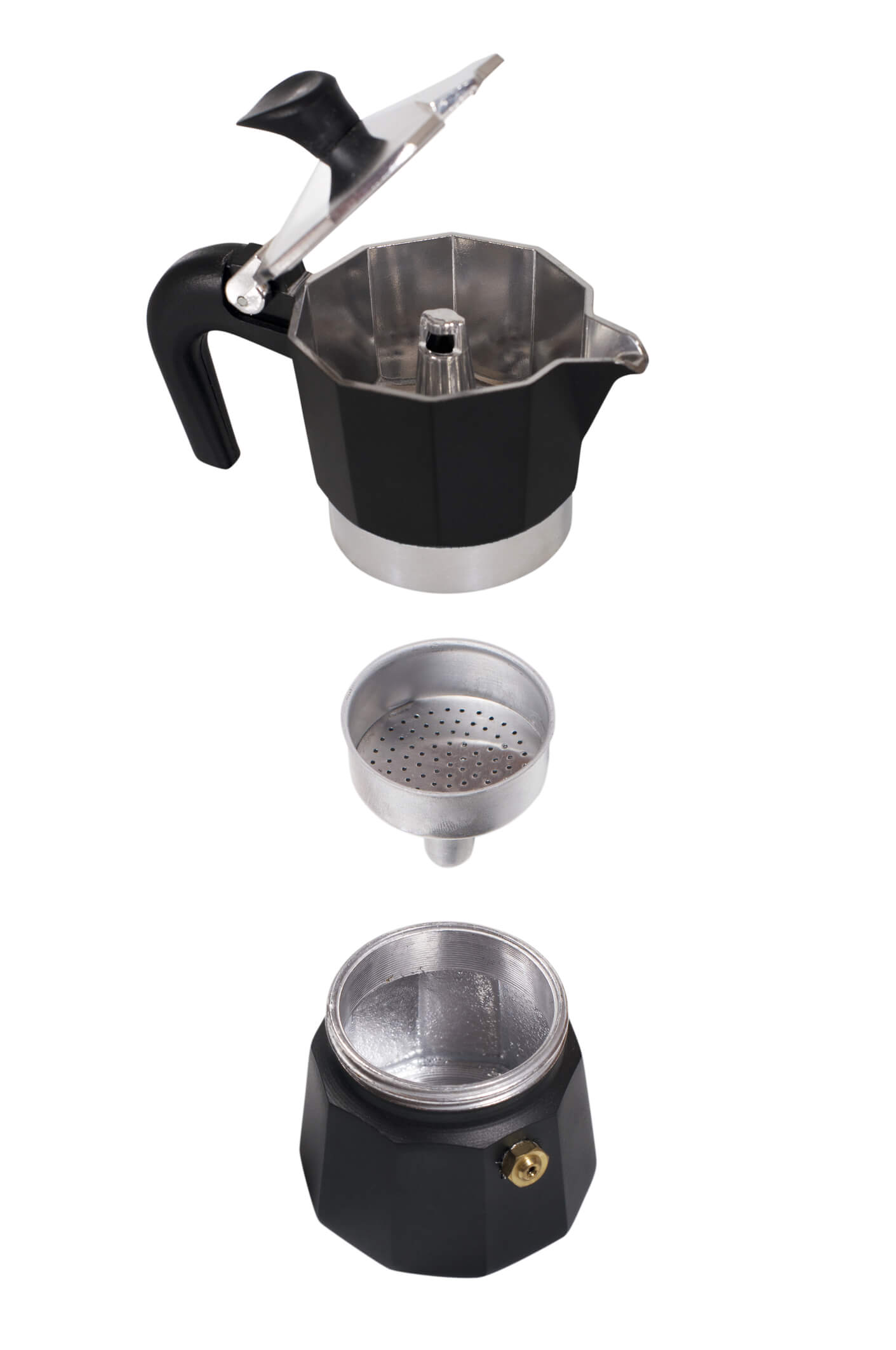Coffee is one of those things in life that can divide a nation. There are coffee vs. tea lovers, milk vs. cream, sugar vs. no-sugar, black vs. additions… You get the picture. And let’s not even get started on all of the crazy options available for coffee machines. Basically, the coffee enthusiasts out there will stand by their cup of joe choices like a die-hard sports fanatic supporting their favorite team. There’s a dark side to this bean water, though, and it’s not the rich brown color. Mold in a coffee maker can make that daily dose of caffeine a serious health hazard.

Whether you’re a Keurig, Nespresso, Ninja, or one of the other brands out there, these creators of coffee all have the potential to harbor harmful particles like that fungus among us. In fact, a 2011 study by the National Sanitation Foundation determined that coffee makers are the fifth germiest item in your kitchen.¹ Out of all the coffee maker reservoirs they sampled, 50 percent had mold or yeast.
It’s a pretty icky thought, especially considering many coffee drinks don’t just have one cup, but several throughout the day.² That means quite a few of those contaminants are making their way into the body, and that’s not including the mycotoxins and mold particles that are in the coffee itself.³’⁴’⁵
In a nutshell, it can be a toxic exposure nightmare for coffee drinkers, which is why it’s important to know what to look for, how to handle a fungus-filled situation, and how to prevent mold in a coffee maker from occurring in the first place.
Mold in a Coffee Maker: The Origin Story
Mold in a coffee maker can happen in the blink of an eye, regardless of which machine is being used. Before getting into that, though, here’s the lowdown on the fungus you’ll be fighting away from one of your favorite kitchen appliances.
Mold 101
So far, over 100,000 species of mold have been identified by researchers so far. Each species reproduces by creating microscopic spores and releasing them into the air.⁶’⁷ These little specks will ride that air current to wherever it leads, often right through a front door and into a home. Typically, this doesn’t cause a problem. Like seeds, spores will remain non-living particles until they’re given the components necessary for life.
With some proper filtration, deep cleaning, and other preventative measures, these particles will be removed from the indoor environment and not cause any health issues. However, if they stumble on a nice, habitable surface within the home, they’ll put down roots called hyphae and start to colonize the area.
This transition marks the beginning of a contamination problem within the home.
Why Does Mold Grow in a Coffee Maker?
Being the hardy little fungus that it is, mold spores only need four main components to transition into the world of the living.⁸
These four elements of life are:
- Oxygen (they need very little, which is why they can grow inside of walls)
- Temperature (40-90°F is preferred, but some species can live in extreme temperatures, which is how mold can grow in refrigerators)
- Food (they eat pretty much everything, like skin cells, wood, and other organic matter)
- Moisture (the often missing puzzle piece)
If these components are present on a surface for 24–48 hours, it offers an opportunity for a lucky spore to grow.
Now picture that coffee maker.
- It’s in a temperature-controlled room filled with oxygen, so those are easily ticked off
- The coffee maker is blasted with all sorts of particles from the kitchen, including skin cells, food specks, dust, and other organic matter
- The machine uses water every time you go for a cup of joe, not to mention the hot, moist air it releases
If steps are not taken to eliminate these growth opportunities, all of the combined components mentioned above can equal a pretty little dream home for a lucky mold spore. Once that mold in a coffee maker settles in, it will begin to reproduce and release more and more spores into the surrounding area. Some species of mold also create microscopic toxins called mycotoxins when threatened, resulting in even more contamination.⁹
The build-up of all these microscopic particles not only contaminates the machine itself and adds harmful contaminants to the coffee brewed, but it also lowers the indoor air quality in the home.

To make it even more of a situation we want to steer clear of, the more spores there are in the surrounding environment, the higher the chance of another colony developing in the kitchen or elsewhere in the indoor space. This is why one mold problem often turns into five, six, or seven more issues throughout the home.
Exposure to such a high level of contaminants can trigger a long list of adverse health reactions, which is why understanding how to prevent mold in a coffee maker is a phenomenal nugget of awareness to have.
Mold in a Coffee Maker: The Health Effect
Mold’s ability to affect health is largely due to the size of the particles in question. Measured in a unit called microns, mold spores and mycotoxins are so small that they’re able to make their way into our bodies through inhalation, absorption, and ingestion.¹⁹ To put it into perspective, a micron is one one-thousandth of a millimeter, meaning you’d have to line up 1,000 microns to equal the distance between those two tiny lines on a ruler. The EPA classifies these types of particles as particulate matter and further breaks them down into two categories.¹⁰
These two categories are:
- PM10: particles that have a diameter of around 10 micrometers or less.
- PM2.5: fine particles that have a diameter of around 2.5 micrometers or less.

As the microscopic particles make their way into the body, the immune system tags them as foreign invaders and immediately attempts to get rid of them ASAP. The tricky thing about mold is that everyone responds differently to exposure. While one individual with mold in a coffee maker may develop a few random symptoms, another may develop over 30 reactions as well as related autoimmune conditions such as Chronic Inflammatory Syndrome or Lyme.
One of the main reasons for the ambiguity surrounding mold’s effect on the body is the lack of research dedicated to this indoor contaminant.
Various factors can play a role in what adverse health reactions are experienced, highlighting the need for a much closer look at this fungus among us.¹¹’¹²’¹³’¹⁴’¹⁵
For instance:
- Some molds are naturally toxic
- Certain species of mold produce mycotoxins
- Some immune systems are more easily overwhelmed
- Genetic predispositions can affect a body’s ability to filter out toxins
- Length of exposure can lead to a worn-out immune system
Not to mention, bacteria can often go hand in hand with mold, especially in a coffee maker. Honestly, the list of related components goes on and can result in an even longer list of potential symptoms.

Common symptoms of mold exposure include:
- Coughing
- Shortness of breath
- Respiratory Problems
- Brain fog
- Chronic fatigue
- Mood swings
- Neurological Issues
- Rashes
- Hair loss
- Digestive problems
Again, you just never know how the body will respond to an exposure issue such as mold in a coffee maker. That’s why prevention is key.
How to Prevent Mold in a Coffee Maker
The best way to deal with mold is to stop it in its tracks. That means removing the components needed for a spore to grow so that a colony doesn’t develop in the first place and actively working to eliminate any spores that make their way inside of a home.
Important note: Always check the manufacturer’s instructions on how to clean your coffee maker and what products to use. Every machine is different, and they’ll be the best experts for that specific brand, whether it’s Keurig, Nespresso, or anything else in between. Also, some machines specifically mention avoiding acidic products such as white vinegar. Using this can void the warranty, so opt for a more diluted version or their recommendations.
Some methods to prevent mold in a coffee maker include:
- Wash removable parts after every use with a mild soap
- Allow the removable parts to dry out completely after every use by leaving them unattached to the machine
- Wipe down the exterior once a week with a botanical cleaner like Benefect Decon 30 (check the manufacturer’s instructions if your machine has an electronic display as this may not be able to be cleaned with a product)
- Avoid keeping any standing water in the machine when it’s not in use
- Deep clean the machine at least once a month
- Focus on kitchen airflow by turning on exhaust vents or cracking windows/doors
- Maintain indoor humidity at 30-50%¹⁶
- Regularly deep clean the kitchen using a HEPA vacuum cleaner, botanical products, and microfiber towels
- Replace as needed (typically, 5–10 years is the replacement date, but keep an eye out for wear and tear, as this can allow for mold growth)
This list will get you well on your way to fighting off mold in a coffee machine. Don’t just stop at your at-home coffee machine, though! Ask a few questions and make sure the common area coffee makers, like those in offices, are properly taken care of as well.
How to Clean a Coffee Maker
Deep cleaning a coffee maker is one of the top preventative measures you can conquer. The process is fairly easy, so it’s a win-win. As stated above, this process should be completed at least once a month.
Tools needed:
- Protective gear: gloves (and a mask for hypersensitive individuals)
- Botanical cleaners: white vinegar and Benefect Decon 30
- Mild soap
- Microfiber rags
- Spray Bottle
- A small scrubby brush
Steps to clean a coffee maker include:
- Put on protective gear
- Remove all removable pieces and soak them in vinegar for half an hour (check the manufacturer’s manual to see what all can be removed).
- Place white vinegar in a spray bottle and then spray all the nooks and crannies in the machine. Allow it to sit for half an hour.
- Wipe all pieces with a microfiber towel. Use a small scrubbing brush for any hard-to-reach areas.
- Wash the removable pieces with a mild soap, wipe them with a microfiber rag, and then allow them to completely air dry.

- Replace all the parts. Place one part vinegar, one part water in the reservoir and then run a cycle on the hottest setting. Stop the cycle halfway through and allow the machine to sit for 30 minutes.
- Run the cycle again to remove any remaining vinegar.
- Run the maker a few more times on the hottest setting to remove any vinegar in the tubing.
- Spray the exterior with Benefect, allow it to sit for 30 seconds, and then wipe with a microfiber towel (check the manufacturer’s instructions if your machine has an electronic display as this may not be able to be cleaned with a product).
- Remove all of the pieces and allow the entire machine to dry completely.
This thorough process will help remove any mineral build-up that can act as a food source for mold, other edible particles, and any present mold spores, all of which help prevent mold growth.
How to Get Rid of Mold in a Coffee Maker
The bad news is that the best way to get rid of mold in a coffee maker is to get rid of the machine and replace it with a new one. All of the particles released by mold or broken up during use have swished and swirled all around the machine, tubing, and gaskets, and are stuck to all the surfaces. Mycotoxins and bacteria, in particular, can stick to surfaces like super glue and are incredibly difficult to remove.
With all of the tubing and small crevices in the machine, that means completely decontaminating can be incredibly difficult. Keep in mind that full decontamination includes removing the thriving mold colony by the roots as well as removing the byproducts and other contaminants (like bacteria) that tagged along for the particle party. Anything left behind can lead to further exposure and adverse health reactions, which is why bleach should never be a go-to option for mold remediation.¹⁷
For hypersensitive individuals experiencing the impacts of exposure, a new machine should absolutely be the course of action taken. The entire kitchen should also be deep cleaned to remove any particles created by mold in a coffee maker. For those who aren’t experiencing any health reactions, you can attempt the cleaning process above to remove the mold, but again, there’s no guarantee all of the contamination will be removed. Make sure to complete the spray and wipe down process at least three times to remove those super-sticky particles like mycotoxins and deep clean the kitchen.
Keep a close eye on the machine after this attempted decontamination. If the mold grows right back or chronic symptoms develop, get rid of the machine as soon as possible, deep clean the kitchen to remove any particles released, and then replace it with a new machine.
How Do You Know If There's Mold in a Coffee Maker?
Detecting if there’s mold in a coffee machine can be tricky. You have to do a thorough inspection as well as rely on your senses for help.
Do You See It?
With so many species existing in the world, mold colonies can come in a variety of colors, shapes, and textures. Some of the most common colors include green, white, grey, blue, red, black, brown, or a combination of them. As for textures, they could be fuzzy, powdery, velvety, or slimy.
If any type of unidentifiable growth pops up in the machine, it's a safe bet to assume there’s a mold problem.
Do You Smell It?
Mold growth isn’t always visible. It could be in a hidden area in the machine like the tubing, or the colony is too small to be visible to the naked eye yet. In this instance, look to your nose to help determine if there’s a problem.
Growing mold often creates an earthy, musty, damp smell due to the release of gasses called microbial volatile organic compounds (MVOC).¹⁸ If this odor is coming from the coffee machine, it points to a problem existing inside.
Do You Taste It?
Unfortunately, this icky scenario can indicate that there’s a problem. The longer that mold grows inside, the more and more particles will enter every cup that you brew. Sure, coffee can taste bitter. But, if you don’t switch up anything in your daily caffeine routine, pay close attention to odd tastes.
If any random abnormalities occur and it just tastes funky, almost like the smells mentioned above, take a closer look at the machine and see if you spot a problem.

Do You Feel Okay?
To make matters even more difficult, not all mold growth is visible, and not all mold growth emits an odor. In cases such as this, it’s important to pay attention to how you feel when around the machine, while drinking the coffee, or after your dose of caffeine. If chronic symptoms seem to spark up or become worse over time, particularly after being around the device, and no doctor can pinpoint a problem, exposure to mold in a coffee machine might be the root cause.
Our bodies are incredible warning systems that will alert us if something’s wrong, including if there’s a contaminant in our indoor environments. It’s up to us to listen to these signals and figure out what the root cause is so that it can be eliminated.
Healthy Fuel for Your Caffeine Routine
A 2020 report from the National Coffee Association showed that 66% of Americans now drink coffee each day, more than any other beverage, including tap water.²⁰

It’s safe to say that there are a whole lot of people out there who really love their bean water. "A hint of mold" is probably not the addition wanted in these cups of caffeine, though.
By actively taking steps to prevent mold in a coffee machine, and ensuring common area coffee machines are properly taken care of, the opportunities for moldy bean water to affect health can be drastically lowered. So, when fueling up for the day, make sure your coffee maker is safe to use and the only extra zest you get is a pep in your step thanks to the caffeine.
Health begins at home. ™
Citations:
- National Sanitation Foundation. (n.d.). 2011 NSF Household Germ Study Summary. NSF. Retrieved from https://d2evkimvhatqav.cloudfront.net/documents/2011_NSF_Household_Germ_Study_exec-summary.pdf
- National Coffee Association . (2022, March 26). NCA releases Atlas of American Coffee . NCA. Retrieved \from https://www.ncausa.org/Newsroom/NCA-releases-Atlas-of-American-Coffee
- Prelle A, Spadaro D, Denca A, Garibaldi A, Gullino ML. Comparison of clean-up methods for ochratoxin A on wine, beer, roasted coffee and chili commercialized in Italy. Toxins (Basel). 2013 Oct 22;5(10):1827-44. doi: 10.3390/toxins5101827. PMID: 24152987; PMCID: PMC3813914.
- Studer-Rohr I, Dietrich DR, Schlatter J, Schlatter C. The occurrence of ochratoxin A in coffee. Food Chem Toxicol. 1995 May;33(5):341-55. doi: 10.1016/0278-6915(94)00150-m. PMID: 7759018.
- Martins ML, Martins HM, Gimeno A. Incidence of microflora and of ochratoxin A in green coffee beans (Coffea arabica). Food Addit Contam. 2003 Dec;20(12):1127-31. doi: 10.1080/02652030310001620405. PMID: 14726276.
- Environmental Protection Agency. (n.d.). Mold. EPA. Retrieved from https://www.epa.gov/mold.
- Centers for Disease Control and Prevention. Basic facts about mold and dampness. Centers for Disease Control and Prevention. Retrieved from https://www.cdc.gov/mold/faqs.htm.
- Lstiburek, J., Brennan, T., & Yost, N. (2002, January 15). Rr-0208: What you need to know about mold. Building Science Corporation. Retrieved from, https://www.buildingscience.com/documents/reports/rr-0208-what-you-need-to-know-about-mold/view.
- World Health Organization. (n.d.). Mycotoxins. World Health Organization. Retrieved from https://www.who.int/news-room/fact-sheets/detail/mycotoxins.
- EPA. (n.d.). Health and Environmental Effects of Particulate Matter (PM). EPA. Retrieved from https://www.epa.gov/pm-pollution/health-and-environmental-effects-particulate-matter-pm.
- Nchh. (n.d.). Mold. NCHH. Retrieved from https://nchh.org/information-and-evidence/learn-about-healthy-housing/health-hazards-prevention-and-solutions/mold/
- Environmental and Occupational Health Assessment Program, & Environmental and Occupational Health Assessment Program, & Health Science Section, Mold Basics for Primary Care Clinicians (2009). Hartford, CT; Connecticut Department of Public Health. , H. S. S., Mold Basics for Primary Care Clinicians 1–10 (2009). Hartford, CT; Connecticut Department of Public Health.
- Curtis, L., Lieberman, A., Stark, M., Rea, W., & Vetter, M. (2004). Adverse health effects of indoor molds. Journal of Nutritional & Environmental Medicine, 14(3), 261-274.
- Bush, R. K., Portnoy, J. M., Saxon, A., Terr, A. I., & Wood, R. A. (2006). The medical effects of mold exposure. Journal of Allergy and Clinical Immunology, 117(2), 326-333
- Fisk, W. J., Lei-Gomez, Q., & Mendell, M. J. (2007). Meta-analyses of the associations of respiratory health effects with dampness and mold in homes. Indoor air, 17(4), 284-296.
- Wild, C. P., & Gong, Y. Y. (2010). Mycotoxins and human disease: a largely ignored global health issue. Carcinogenesis, 31(1), 71-82.
- Environmental Protection Agency. (n.d.). What does mold smell like? EPA. Retrieved from https://www.epa.gov/mold/what-does-mold-smell
- EPA. (n.d.). Should I use bleach to clean up mold? EPA. Retrieved from https://www.epa.gov/mold/should-i-use-bleach-clean-mold.
- EPA. (n.d.). A Brief Guide to Mold, Moisture, and Your Home. EPA. Retrieved from https://www.epa.gov/mold/brief-guide-mold-moisture-and-your-home#tab-6.
- Environmental Protection Agency. (n.d.). What does mold smell like? EPA. Retrieved from https://www.epa.gov/mold/what-does-mold-smell.
- National Coffee Association . (2022, March 15). Coffee consumption hits two-Decade high. NCA. Retrieved from https://www.ncausa.org/Newsroom/Coffee-consumption-hits-two-decade-high-2022-NCDT.

